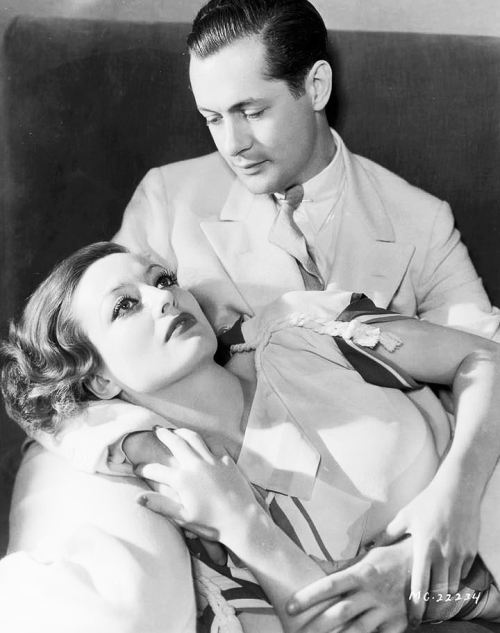Em 2013, o responsável pela programação do canal
TCM Charlie Tabesh nos revelou que um dos filmes mais solicitados pelo público
é “Redimida” (1932). E foi por esta recomendação indireta que eu procurei o
filme, e não me decepcionei. Porque é Joan Crawford. E é pre-Code.
In 2013, TCM’s
vice-president of programming Charlie Tabesh said that one of the most
requested films to be shown on the channel is “Letty Lynton” (1932). And it was
because of this indirect recommendation that I looked for the movie, and wasn’t
disappointed. Because it has Joan Crawford. And it is a pre-Code!
Letty (Joan Crawford) está em Montevidéu com seu
amante, Emile (Nils Asther), mas está decidida a embarcar em um navio de volta
para casa. Nas cenas com ele, Joan se comporta de maneira afetada e com ares
aristocráticos, lembrando Greta Garbo. E isso não é de se espantar, se considerarmos
que o diretor de “Letty Lynton”, Clarence Brown, dirigiu sete filmes com Garbo,
incluindo o maravilhoso “A Carne e o Diabo” (1926). E Nils Asther, por sua vez,
foi criado na Suécia, descoberto por Mauritz Stiller, mentor também de Garbo, e
trabalhou com Greta em dois filmes de 1929.
Letty (Joan Crawford) is in Montevideo with her lover,
Emile (Nils Asther), but she has made up her mind and will board a ship back
home. In her scenes with Emile, Joan behaves in an affected manner and has an
aristocratic look, reminding us of Greta Garbo. And this is something to
notice, considering that the director Clarence Brown directed Garbo in seven
films, including the wonderful “Flesh and the Devil” (1926). And Nils Asther,
in turn, was raised in Sweden, discovered by Mauritz Stiller, also Garbo’s
mentor, and worked with Greta in two films from 1929.
No navio, ela conhece Jerry (Robert Montgomery),
e os dois conversam. Letty é agora autêntica e risonha, do jeito que estamos
acostumados a ver Joan Crawford no começo dos anos 30.
In the ship, she meets Jerry (Robert Montgomery) and
they chat. Letty is now authentic and all smiles, in the way we are used to see
the early 1930’s Joan Crawford.
Jerry a pede em casamento, na proposta mais
simples da história do cinema, e ela aceita. Entretanto, chegando em Nova York,
ela reencontra Emile, que a ameaça. E este não é o único problema de Letty: ela
precisa retomar a relação com a mãe, de quem se afastou para viver com Emile.
Jerry asks her to marry him, in the simplest proposal
in all film history, and she says yes. However, when they arrive in New York,
she meets again with Emile and is blackmailed by him. And this is not Letty’s
only problem: she needs to fix her relationship with her mother. They are
estranged since Letty left home to live with Emile.
Algo que me encanta no pre-Code e que não
foi totalmente recuperado até hoje é a ausência de falsos moralismos. Só porque
Letty viveu uma relação com um canalha abusivo, significa que ela não merece
ser feliz? Uma mulher que “peca” não merece uma segunda chance? No cinema pre-Code,
ela merece. No mundo real, na sociedade hipócrita, nem sempre.
Something that pleases me in the pre-Code era (and
something that was not yet totally recovered) is the absence of fake moralism.
Only because Letty had an abusive relationship with an asshole, does it mean
that she will never deserve to be happy?
A woman who sins doesn’t deserve a second chance? In pre-Code cinema,
she does. In the real world, in the
hypocritical society, not always.
O filme fica excitante em sua última meia hora.
São estes minutos, em especial os finais, que atestam que o filme foi feito na
era pre-Code. O final levou o
filme a ser banido na Inglaterra, mas esta não foi a maior punição de “Letty
Lynton”.
The film becomes exciting
in its last half hour. Those minutes, especially the last ones, guarantee that
we are watching a pre-Code. The ending made the film be banished in England,
but this was not the biggest punishment for “Letty Lynton”.
Em 1936, uma decisão
judicial tirou o filme de circulação devido a uma acusação de plágio por parte
dos autores da peça “Dishonored Lady”. Desde então o filme é difícil de
encontrar: não foi restaurado ou lançado em VHS, DVD ou Blu-Ray, e as cópias
disponíveis na internet têm som e imagem de baixa qualidade. “Dishonored Lady”
foi legalmente adaptada para o cinema em 1947, em um filme estrelando Hedy
Lamarr.
In 1936, a court decision
took the film out of circulation because of a plagiarism accusation made by the
authors of the play “Dishonored Lady”. Since then the film is hard to find: it
wasn’t restored nor released in VHS, DVD or Blu-Ray, and the copies available
in the internet have low quality sound and image. “Dishonored Lady” was legally
adapted to the screen in 1947, in a film starring Hedy Lamarr.
E toda essa confusão
impediu que várias gerações conhecessem o famoso vestido feito por Adrian para
Joan em “Letty Lynton’’. Ela o usa quando Jerry a pede em casamento, e o
vestido causou uma corrida às lojas. Adrian quis devolver a feminilidade aos
figurinos, e conseguiu isto com enormes mangas de organza e uma cintura bem
marcada.
And all this confusion
prevented several generations from knowing the famous dress made by Adrian to
Joan in “Letty Lynton”. She wears it when Jerry proposes, and the dress caused
a race to stores in search for copies. Adrian wanted to give femininity back to
outfits, and succeeded with huge organza sleeves and a very marked waist.
É uma pena que “Letty
Lynton” não esteja disponível para todos. Passados os primeiros minutos
monótonos, é um bom filme, com Joan magnífica. Seria ótimo se, à moda pre-Code, a velha lei fosse revista e
este filme voltasse a ser exibido.
It is a shame that “Letty
Lynton” is not availabe for us all. After the first monotonous minutes, the
film becomes good, with a magnificent Joan. It’s be great if, in pre-Code
fashion, the old law was reconsidered and this film was once again shown.
This is my contribution to
the Joan Crawford Blogathon, hosted by Crystal at In the Good Old Days of
Classic Hollywood.




6 comments:
nossa, as imagens geraram muita curiosidade, quero muito, mas muito mesmo ver. beijos, pedriat
You have intrigued me and I must see this film. Again, a most excellent write-up.
This is certainly an interesting film, isn't it?
I grew up in the '80s in England watching nth generation VHS copies or illicit pre-cert tapes we bought from unscrupulous market stall owners because the censors were blocking us from seeing much of what we wanted. I'd actually forgotten what that actually felt like until I watched a dubious VHS rip of Letty Lynton for this blogathon. We're spoiled in the 21st century by sheer availability and this made me nostalgic for the dark old days, while realising that we're still not at the point where everything's available on tap.
I like how you went with stills rather than screenshots. You got much better imagery than I did, especially with that glorious shot of the Letty Lynton dress. Good call on mentioning Garbo too. Asther was often described as the male Garbo.
Great review! I really enjoyed reading it. Letty Lynton has such a fascinating background story, and of course that white dress! It's definitely a statement!
This film looks gorgeous, judging by the images you've posted. And I agree, that white dress is quite stunning!
Thanks for introducing me to this little-known film. I hope to run across it sometime. :)
I had no idea about the plagiarism accusation!! I always thought this movie was well known due to always reading about the famous dress in numerous fashion books. Dishonored Lady is on my to-watch list. I didn't know of its connection to this film. Now I do! Great post!!
Post a Comment